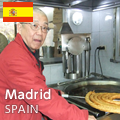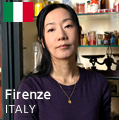Food culture is very important here: people love eating, enjoy cooking and most of all they appreciate discussing recipes and food preparation in between meals.
Food is also culture, social interaction and a way ‘to break the ice.’
Easter is approaching and so are the typical recipes of this time of the year.
The period preceding Easter is called Lent (Quaresima in Italian) and in Genoa we traditionally make or buy and eat the Genoese quaresimali, biscuits made with almond paste, sugar, orange blossom water, egg white, flour, then garnished with fondant sugar and often flavored with maraschino liqueur, pistachio, lemon or coffee. They still can be seen today in various historic confectionery-pastries shop of the Ligurian cities and, in Genoa, the ones from the ancient family-run confectionery shops in the old town are the most famous ones.
The origin of preparing Genoese quaresimali sweets dates back to around 1500, when the nuns of the convents on the hills behind Genoa worked the almond paste with sugar without adding animal products such as butter because it was forbidden by the Catholic religion in the forty days before Easter.
In this way they could enjoy sweets without breaking the rules.

Genoese quaresimali
However, they are sweets that many families love to make at home, with ancient recipes passed down from generation to generation: each family has its own, slightly different in flavors and proportions.
Around Easter time, there is also a Ligurian sweet in the shape of a small basket with a handle, inside which a whole boiled egg with is placed. The cavagnetto (Ligurian dialect for the word basket) is considered the typical Easter sweet of the hinterland. The recipe is ancient and has been handed down from generation to generation up to the present day. It has always been a symbol of Easter as it was prepared on Easter Eve and taken to church by children for blessing, then eaten with the family the following day. The dough is the same as that used to make the famous canestrelli biscuits, a sweet known throughout Liguria, but its particular shape distinguishes it and makes it unique.
The leavening is essential for the success of this sweet, the times for which must therefore be respected, even if long. I have never tried to make it myself but I have purchased it from local bakeries.
Also cavolini with whipped cream are a small jewel of Ligurian pastry, perfect to end a meal or for a sweet break. This delicate and refined dessert is loved for its simplicity and irresistible taste and it has deep roots in the Ligurian pastry tradition.
The term cavolini refers to small cream puffs, made with choux pastry, a light and versatile dough of French origin, which has found a special place in Italian recipes and pastry shops. In Liguria, the cavolini are filled with a soft and light whipped cream cream, creating a perfect balance between sweetness and lightness.
Ingredients for cavolini :
100 grams of white flour
100 grams of water
100 grams of butter
2 eggs
30 grams of sugar
whipped cream
Instructions:
First boil the water with the butter and sugar and, once it boils, remove from the heat and pour in the flour.
Mix and blend well, putting it back on the heat, keep stirring it continuously until the dough comes away from the sides of the pan.
Allow the mixture to cool and then pour in the eggs one at a time, continuing to mix.
Place the mixture in teaspoonfuls on a buttered baking tray.
Cook at medium heat for about twenty minutes.
Fill them with whipped cream by cutting them on one side and finally cover them with granulated sugar.

Cavolini Liguri






























































